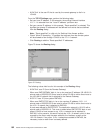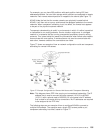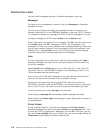
Validation List:
Click the Authorization tab; then click New or Open to enter
authorization information.
1. Add a validation list for remote LANs A, B, and C by using PAP or CHAP
authentication.
2. Click OK when the validation list is completed.
3. Click OK to close the connection profile properties page.
Example: Remote LAN Access with Dynamic Routing (RIP)
Remote LAN access with dynamic routing allows remote clients on separate LANs
to communicate with one another as if they were on the same routing domain. It
enables any host in the corporate network to communicate with any remote LAN
host. Dynamic routing from the home network places no address restrictions on the
remote network. Further, there is no need for a hierarchical address scheme or
relationship from the host to the home address space.
The home network is able to learn about the remote networks by using a dynamic
routing algorithm within the home network using RIP 1 or 2. This is accomplished
by the home network updating its routing tables as information is extracted from the
remote networks static routing table.
The number of remote networks directly affects the size of the dynamic routing
tables. No dynamic routing protocols run on the remote PPP links. Instead, they are
run by AS/400 and the corporate network. The routing protocol automatically
redistributes remote routes throughout the corporate network.
A solution where the corporate network is running RIP 1 or 2 as its routing protocol
and
the remote links are connecting to a small amount of networks would be to
implement remote LAN access with dynamic routing. If RIP 1 or 2 is being run in
AS/400, the static routes will automatically be redistributed. This eliminates the
need to run RIP over the remote links.
Figure 79 on page 108 shows an example of how a network configuration could use
RIP for remote LAN access.
Figure 78. Example Routing for Transparent Subnetting
Chapter 4. Configuring Point-to-Point TCP/IP (PPP and SLIP) 107


















